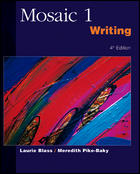|
 |  Mosaic 1 Writing, 4/e Laurie Blass
Meredith Pike-Baky
An Endangered Species| Narrator: Tree kangaroos are comfortable living a good distance off the ground. Here at the San Diego Zoo the normally shy and reclusive animals seem to tolerate visitors.Woman: Do you know what a baby kangaroo's called? Baby kangaroos are called joeys.Narrator: Instead of bounding across the earth in giant leaps like other kangaroos, they climb trees and move easily from limb to limb. Tree kangaroos use their curved claws to hold on to branches, and they depend on their long muscular tail for balance.Zookeeper: They can move their rear limbs independently of one another. They're not restricted by the traditional kangaroo hop.Narrator: the largest variety of tree kangaroos is found in the tropical forests of New Guinea. Scientists aren't sure how many of these unique animals are left but they think that the tree kangaroo is on the verge of extinction. Not only is the animal losing prime habitat to development, but it's often hunted for food.Betts: So, when you ask people to sort of rate their favorite meat to eat, they'll say the tree kangaroo is always near the top of the list of at the top of the list.Narrator: Researcher Will Betts studies tree kangaroos in New Guinea. He captured this one on videotape. Betts tracks what they eat, how they behave, and where they live. The results of his painstaking work are passed on to a group of zoos committed to saving the tree kangaroo from extinction.Zookeeper: Very little is known about them so whatever we do learn about them we can use to prove their husbandry in captivity and, hopefully, their conservation situation in the wild.Narrator: One day conservationists hope to establish a sanctuary to protect the animals. In the last decade, two new species of tree kangaroos have been identified in New Guinea. Researchers believe there may be more discoveries if the tree kangaroo can survive its loss of habitat and the deadly aim of hunters. |
|
|



 2002 McGraw-Hill Higher Education
2002 McGraw-Hill Higher Education

 2002 McGraw-Hill Higher Education
2002 McGraw-Hill Higher Education